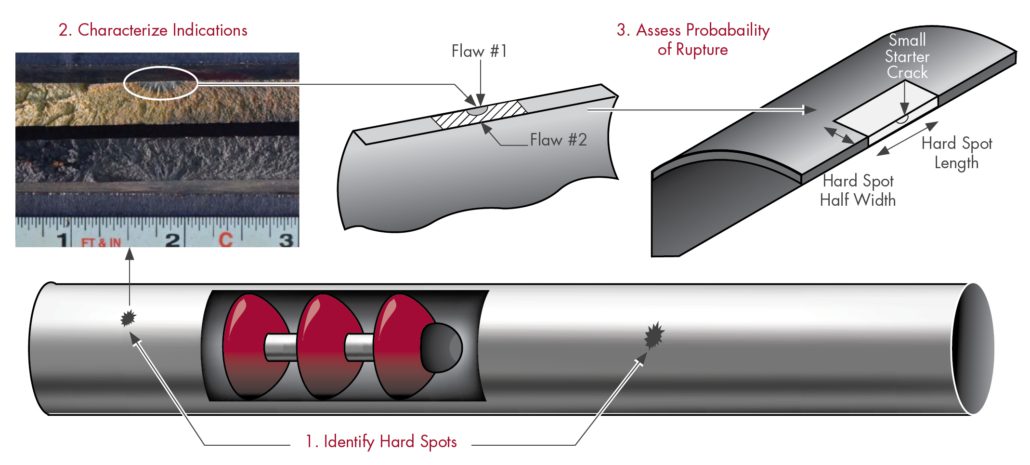News and Views, Volume 54 | Structural Integrity Supports Pipeline Research Council International’s Hard Spot Project
By Scott Riccardella and Steven Osgood
Structural Integrity is pleased to be working with PRCI to improve ILI performance, provide industry insight regarding prioritizing hard spots, and determine the optimal repair methodologies.
SI’s Pipeline Integrity Compliance Solutions (PICS) group has been implementing a highly strategic project from the Pipeline Research Council International (PRCI) focused on enhancing industry capabilities to detect and assess hard spot anomalies in gas transmission and hazardous liquid pipelines.
PRCI reviewed proposals from several highly qualified firms to support this project. Ultimately, SI was selected to provide support based on a combination of our expertise and integrated proposal, which demonstrated capabilities in field assessment, engineering analysis, and a reputation for providing synchronized follow-up. Being part of this PRCI project reinforces SI’s dedication to helping improve pipeline integrity and assessment practices and further position SI as an expert consulting partner for supporting pipeline operators’ fracture mechanics and in-line inspection (ILI) needs.
About the Project
Hard spots, or localized areas with elevated hardness within the pipe body, were believed to form during manufacturing. Hard spots are prevalent in piping produced by certain manufacturers and/or within certain vintages. They are believed to be attributed to inadequate quality control in the steelmaking, pipe-rolling, and welding processes. Over time, when in specific environmental conditions, cracking can initiate in the hard spots, creating a significant hazard. PRCI issued an RFP focused on evaluating and enhancing ILI tool technology and complementary analytical capabilities to reliably detect, size, and characterize the threat to integrity caused by hard spots.
Project Objective and Details
The project objective is to help the industry better understand ILI performance for more accurate detection and characterization of hard spots, providing targeted feedback, and developing insights to help improve ILI performance and prioritize ILI results.
ILI Performance Evaluation Study
The project’s main task is to evaluate the performance of various ILI technologies and service providers in identifying and characterizing hard spot defects. Testing is performed at the PRCI Technology Development Center (TDC) with pipeline samples (with various hard spot features) removed from service and configured in a test string for pull-through testing from several participating service providers. SI has characterized these samples using advanced NDE methodologies to establish reference data that will be used for determining the probability of detection (POD), probability of identification (POI), sizing accuracy, hardness estimation accuracy, and location accuracy. Individual performance reports will be provided as feedback to the participating ILI service providers to facilitate improving and advancing ILI technologies for hard spot detection and characterization.
Developing the Repair/Response Criteria
Following this testing, SI will complete additional analysis and modeling of the ILI Reported Values versus measured dimensions and hardness values for associated error. SI will also perform modeling to develop statistical correlations (with associated uncertainties) for estimating the Peak Hardness & Hard Spot Length from ILI Reported Values. Data will be analyzed in the context of historical failures and regulatory definitions of a hard spot. SI will develop an assessment methodology to evaluate hard spot criticality with a recommended response criterion (feature prioritization scheme) based on feature severity (length, hardness) and relative safety margin (Predicted Failure Pressure / MAOP).
“This project helps advance a critical initiative for PRCI, helping improve ILI capabilities to address a key threat to pipeline integrity. We are grateful to be partnering with Structural Integrity to develop and deploy this knowledge to our members.”
Jim Wayman – Program Manager Integrity and Inspection – PRCI
Evaluation & Recommendation of the Repair Methodology
SI is also working to complete research on different material properties and repair methodologies to determine the suitability of repairs. As part of this task, SI will complete a benchtop study using finite element analysis (FEA) to study the effectiveness of each repair approach (composites and Type A sleeves) leveraging the fitness for service (FFS) methodology detailed in the prior task (Repair/Response Criteria).



